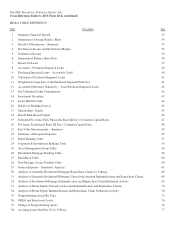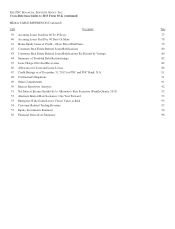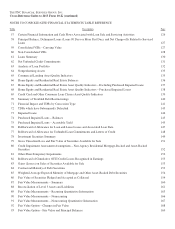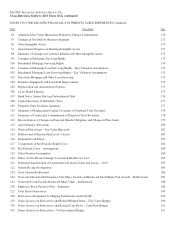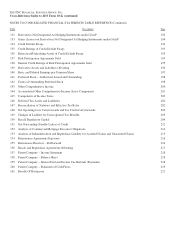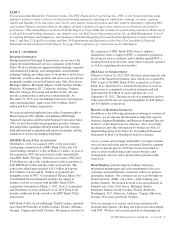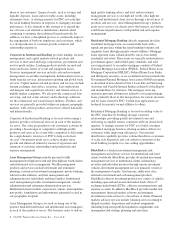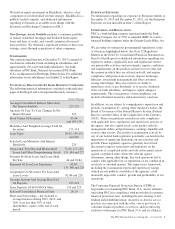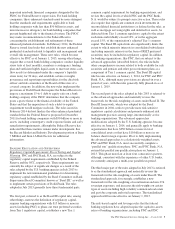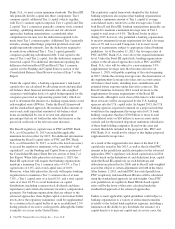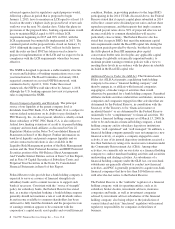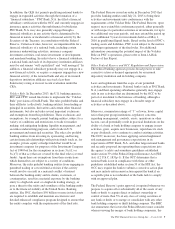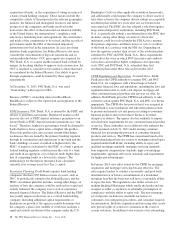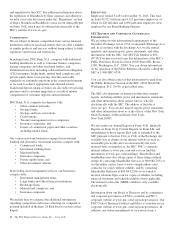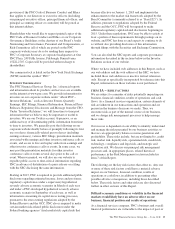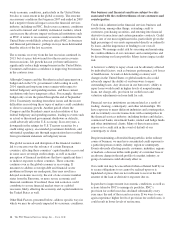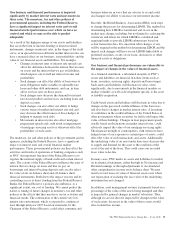PNC Bank 2013 Annual Report Download - page 24
Download and view the complete annual report
Please find page 24 of the 2013 PNC Bank annual report below. You can navigate through the pages in the report by either clicking on the pages listed below, or by using the keyword search tool below to find specific information within the annual report.Bank, N.A., to meet certain minimum standards. The Basel III
rule generally divides capital into three components: Tier 1
common capital, additional Tier 1 capital (which, together,
with Tier 1 common capital comprises Tier 1 capital) and Tier
2 capital. Tier 1 common is generally common stock, retained
earnings, qualifying minority interest and, for advanced
approaches banking organizations, accumulated other
comprehensive income, less the deductions required to be
made from Tier 1 common equity. Additional Tier 1 generally
includes, among other things, perpetual preferred stock and
qualifying minority interests, less the deductions required to
be made from additional Tier 1. Tier 2 capital generally
comprises qualifying subordinated debt. Total capital is the
sum of Tier 1 and Tier 2 capital, less the deductions required
from total capital. For additional information regarding the
differences between Basel III and Basel I Tier 1 common
capital, see the Funding and Capital Sources section of the
Consolidated Balance Sheet Review section of Item 7 of this
Report.
Under the capital rules, a banking organization’s risk-based
capital ratios are calculated by allocating assets and specified
off-balance sheet financial instruments into risk-weighted
categories (with higher levels of capital being required for the
categories perceived as representing greater risk), which are
used to determine the amount of a banking organization’s total
risk-weighted assets (RWAs). Under the Basel I framework
and the standardized approach, the nominal dollar amounts of
assets and credit equivalent amounts of off-balance sheet
items are multiplied by one of several risk adjustment
percentages that are set forth in the rules that increase as the
perceived credit risk of the relevant asset increases.
The Basel I regulatory capital ratios of PNC and PNC Bank,
N.A. as of December 31, 2013 exceeded the applicable
minimum levels in effect for 2013. For additional information
regarding the Basel I capital ratios of PNC and PNC Bank,
N.A. as of December 31, 2013, as well as the levels necessary
to exceed the regulatory minimums or be considered “well
capitalized”, see the Funding and Capital Sources portion of
the Consolidated Balance Sheet Review section of Item 7 of
this Report. When fully phased-in on January 1, 2019, the
Basel III capital rule will require that banking organizations
maintain a minimum Tier 1 common ratio of 4.5%, a Tier 1
capital ratio of 6.0%, and a total capital ratio of 8.0%.
Moreover, when fully phased-in, the rule will require banking
organizations to maintain a Tier 1 common ratio of at least
7.0%, a Tier 1 capital ratio of at least 8.5%, and a total capital
ratio of at least 10.5% to avoid limitations on capital
distributions (including common stock dividends and share
repurchases) and certain discretionary incentive compensation
payments. For banking organizations that are subject to the
advanced approaches, these higher capital conservation buffer
levels above the regulatory minimums could be supplemented
by a countercyclical capital buffer of up to an additional 2.5%
during periods of excessive credit growth, although this buffer
is initially set at zero in the United States.
The regulatory capital framework adopted by the federal
banking regulators also requires that banking organizations
maintain a minimum amount of Tier 1 capital to average
consolidated assets, referred to as the leverage ratio. Under
both Basel I and Basel III, banking organizations generally are
required to maintain a minimum leverage ratio of Tier 1
capital to total assets of 4.0%. The Basel I rules in effect
during 2013, however, also permitted a banking organization
to meet its minimum leverage requirement if it had a leverage
ratio of 3% and was rated Composite 1 in its most recent
report of examination, subject to appropriate federal banking
guidelines. As of December 31, 2013, the leverage ratios of
PNC and PNC Bank, N.A. were above the required minimum
level. Under the Basel III capital rule, banking organizations
subject to the advanced approaches (such as PNC and PNC
Bank, N.A.) also will be subject to a new minimum 3.0%
supplementary leverage ratio that becomes effective on
January 1, 2018, with public reporting of the ratio beginning
in 2015. Unlike the existing leverage ratio, the denominator of
the supplementary leverage ratio takes into account certain
off-balance sheet items, including loan commitments and
potential future exposure under derivative contracts. The
Basel Committee in January 2014 issued revisions to the
supplementary leverage requirements of the Basel III
framework, although it is not clear at this time to what extent
these revisions will be incorporated by the U.S. banking
agencies into the U.S. capital rules. In August 2013, the U.S.
banking agencies requested comment on a proposed rule that
would raise the supplemental leverage ratio for U.S. bank
holding companies that have $700 billion or more in total
consolidated assets or $10 trillion or more in assets under
custody and for the insured depository institution subsidiaries
of these bank holding companies. Based on the asset and
custody thresholds included in the proposed rule, PNC and
PNC Bank, N.A. would not be subject to this higher proposed
supplemental leverage ratio.
As a result of the staggered effective dates of the final U.S.
capital rules issued in July 2013, as well as the fact that PNC
remains in the parallel run qualification phase for the advanced
approaches, PNC’s regulatory risk-based capital ratios in 2014
will be based on the definitions of, and deductions from, capital
under the Basel III capital rule (as such definitions and
deductions are phased-in for 2014) and its Basel I risk-weighted
assets (but subject to certain adjustments set forth in the rules).
After January 1, 2015, and until PNC has exited parallel run,
PNC’s regulatory risk-based Basel III ratios will be calculated
using the standardized approach for risk-weights. Once PNC
exits parallel run, its regulatory Basel III risk-based capital
ratios will be the lower of the ratios calculated under the
standardized approach or the advanced approaches.
Failure to meet applicable capital guidelines could subject a
banking organization to a variety of enforcement remedies
available to the federal bank regulatory agencies, including a
limitation on the ability to pay dividends, the issuance of a
capital directive to increase capital and, in severe cases, the
6The PNC Financial Services Group, Inc. – Form 10-K


